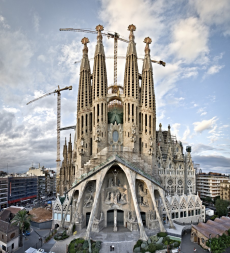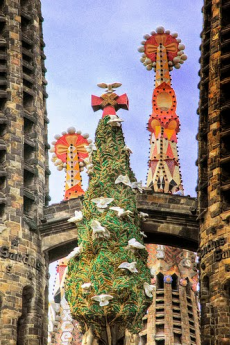
The Basilica i Temple Expiatori de la Sagrada Família, or Sagrada Família or Holy Family, is a large Catholic church in Barcelona, Catalonia, the capital city of Spain. It was designed by Antoni Gaudí, the best known practitioner of the Catalonian Modernism architectural style. This movement aimed to celebrate Catalonian culture, drawing on the region’s rich history with both Medieval and Arab features. It also emphasised curved lines, and rich decoration with organic, natural motifs.
The Basilica was first the project of bookseller Josep Maria Bocabella, who founded the Spiritual Association of Devotees of St. Joseph. After visiting the Vatican in 1872, he returned to Spain determined to build a church like those he’d seen in Italy. He collected donations, and the construction began in 1882 under the direction of architect Francisco de Paula del Villar. When Villar quit in 1883 only the apse crypt had been completed, at which point Gaudí assumed control and radically changed the design. He was appointed Architect Director in 1884; upon his death in 1926 his close collaborator Domènec Sugrañes i Gras took over the management. At that point not even a quarter of the work had been completed.
Construction under Sugrañes was brought to a halt in 1936 with the beginning of the Spanish Civil War. Catalan anarchists destroyed parts of the unfinished building as well as Gaudí’s workshop. Gaudí rarely drew detailed plans of his works, preferring to create three-dimensional scale models, moulding the details to them as he went. These, along with original plans, drawings and photographs were all destroyed. Since 1940 a variety of architects have continued the work, using reconstructed plans and modern variations.

The Sagrada Família has a very complex design, including double aisles, seven chapels, many towers and three large entrances, each with a different theme: the Passion, Nativity and Glory façades. The Nativity façade was the first to be completed; it celebrates the birth of Jesus, and is covered with statutes of plants and animals. The Passion façade is dedicated to Christ’s suffering on the cross, and is much more austere in design. Construction of the Glory façade began in 2002.
Gaudí’s original design calls for a total of eighteen spires, representing the twelve apostles, the Virgin Mary, the four Evangelists and, the tallest, Jesus Christ. Each spire will be decorated by sculptures of their traditional symbols, with a lion for St Mark, an eagle for St John and so on. Once the spires are completed, the Sagrada Família will be the tallest church building in the world.
The current director, Jordi Bonet i Armengol has been using computers to aid the process since the 1980s. This and other modern technology have accelerated the construction of the building, which had been expected to take hundreds of years.
The central nave vaulting was completed in 2000, and since then construction of the transept vaults, apse and the supporting structure of the largest tower have been the main focus. In 2008 some renowned Catalonian architects advocated putting a halt to the construction to respect Gaudí’s original designs, but this was overruled. Currently the estimated completion date is 2028.
Despite its state of incompletion, the Sagrada Família is the most visited monument in Spain, as well as a UNESCO World Heritage Site. In 2010 Pope Benedict XVI consecrated and proclaimed it a minor basilica, and the building is now used for religious services.
Images: http://ad009cdnb.archdaily.net.s3.amazonaws.com/wp-content/uploads/2013/10/52544190e8e44eff020006cf_ad-classics-la-sagrada-familia-antoni-gaudi_sfpassio-908x1000.jpg
https://upload.wikimedia.org/wikipedia/commons/thumb/6/63/Barcelona_Sagrada_Familia_(2052656629).jpg/681px-Barcelona_Sagrada_Familia_(2052656629).jpg

0 Comment:
Be the first one to comment on this article.